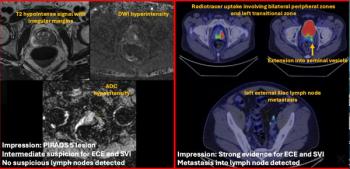
Can Cardiac CT be a Viable Alternative for Diagnosing Coronary Artery Disease?
For patients with stable chest pain and suspected coronary artery disease (CAD), emerging evidence shows that cardiac computed tomography (CT) has a lower risk of major procedure-related complications than catheterization.
(Editor’s note: This article has been adapted from its original publication on our sister site
Cardiac computed tomography (CT) may provide a safer option than coronary angiography for assessing patients with stable chest pain and suspected coronary artery disease (CAD), according to
In the randomized multicenter DISCHARGE trial, which involved over 3,500 patients with stable chest pain, researchers found that initial cardiac CT and coronary angiography had similar cardiovascular risks, but the
“The trial confirmed that the CT-based examination is safe in patients with stable chest pain and suspected coronary artery disease,” said Marc Dewey, MD, head of the Department of Radiology on Campus Charité Mitte. “Among the patients referred for cardiac catheterization and included in this trial, the risk of major cardiovascular events was found to be similar in both the CT and catheterization groups, occurring in 2.1% and 3.0% of patients, respectively. The incidence of major, procedure-related complications was found to be lower in patients managed with an initial CT strategy.”
Conducted across 26 European medical centers from October 3, 2015 to April 12, 2019, the DISCHARGE trial enrolled 3,667 patients who were randomized in a 1:1 ratio to undergo CT or invasive coronary angiography. Of the 3,667 enrolled, 3,561 were included in a modified intention-to-treat analysis.
To be considered eligible for the study, patients needed to be at least 30 years of age and referred for invasive coronary angiography at a study site because of stable chest pain with an intermediate pretest probability of obstructive CAD. Investigators noted a web-based system was used to ensure concealment of group assignments after eligibility criteria had been checked.
As part of the study protocol, it was recommended that patients in either arm without obstructive CAD be discharged from the trial center back to their referring physician for further treatment while those with obstructive CAD were treated according to guidelines.
The primary outcome of interest for the study was incidence of major adverse cardiovascular events, which was a composite of cardiovascular death, nonfatal MI, or nonfatal stroke. Secondary outcomes of interest included major procedure-related complications occurring during or within the first 48 hours after CT or invasive coronary angiography.
Of the 3,561 people included in the intention-to-treat analysis, 1,808 represented the CT group and 1,753 patients were in the invasive coronary angiography group. Baseline characteristics of patients were similar between the study groups and the median follow-up time was 3.5 (IQR, 2.9-4.2) years.
During the follow-up period, a total of 90 major adverse cardiovascular events occurred among the study cohort, with events occurring among 2.1% in the CT group and 3.0% in the invasive coronary angiography group (HR, 0.70 [95% CI, 0.46-1.07]; P=.10). When assessing major procedure-related complications, 42 such events were identified by investigators, with these events occurring in 0.5% of the CT group and 1.9% of the invasive coronary angiography group (HR, 0.26 [95% CI, 0.13-0.55]). Assessments of angina among study participants during the final four weeks of follow-up indicated angina was reported by 8.8% of the CT group and 7.5% of the invasive coronary angiography group (HR, 1.17 [95% CI, 0.92-1.48]).
“Now that it has been standardized and quality tested as part of the DISCHARGE trial, this method could be made more widely available as part of the routine clinical care of people with intermediate CAD risk,” said Henryk Dreger, Deputy Head of Charité’s Department of Cardiology and Angiology.
Newsletter
Stay at the forefront of radiology with the Diagnostic Imaging newsletter, delivering the latest news, clinical insights, and imaging advancements for today’s radiologists.




























